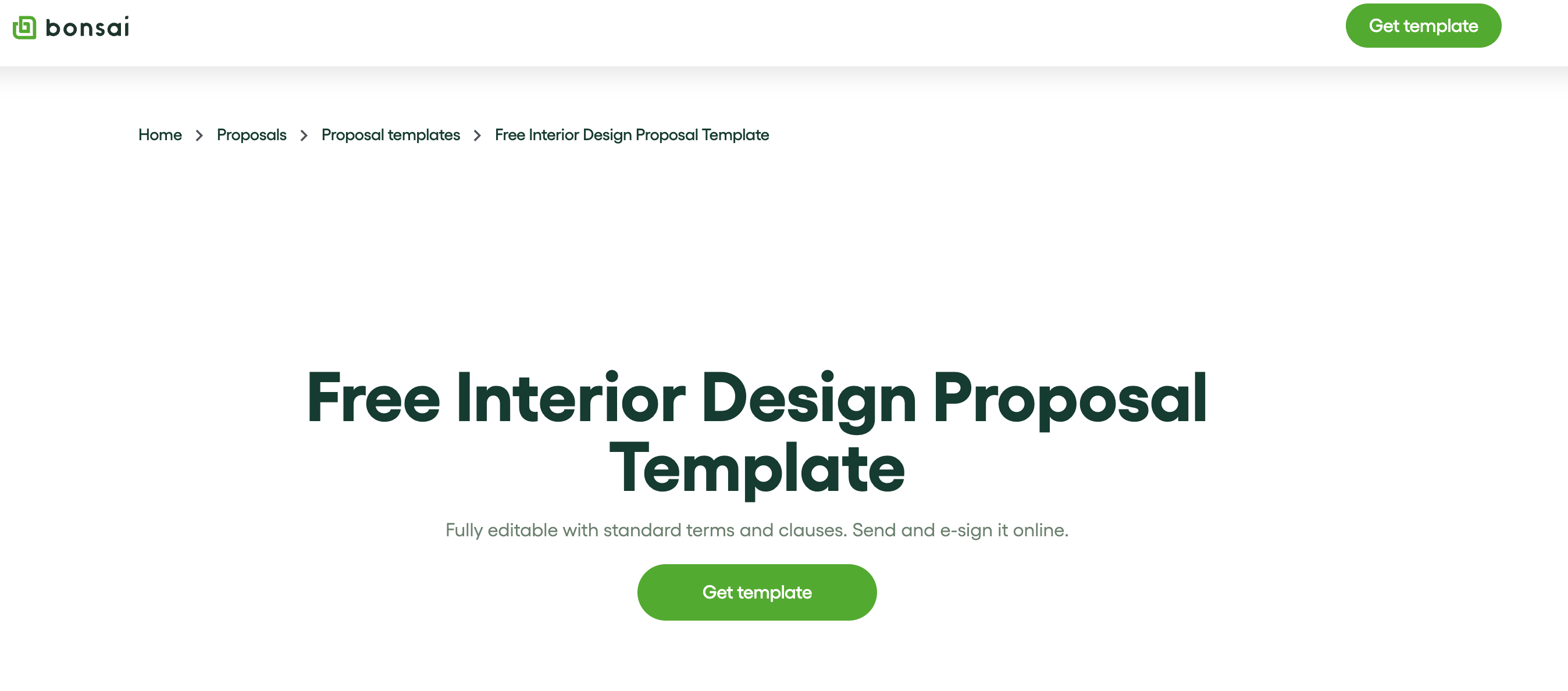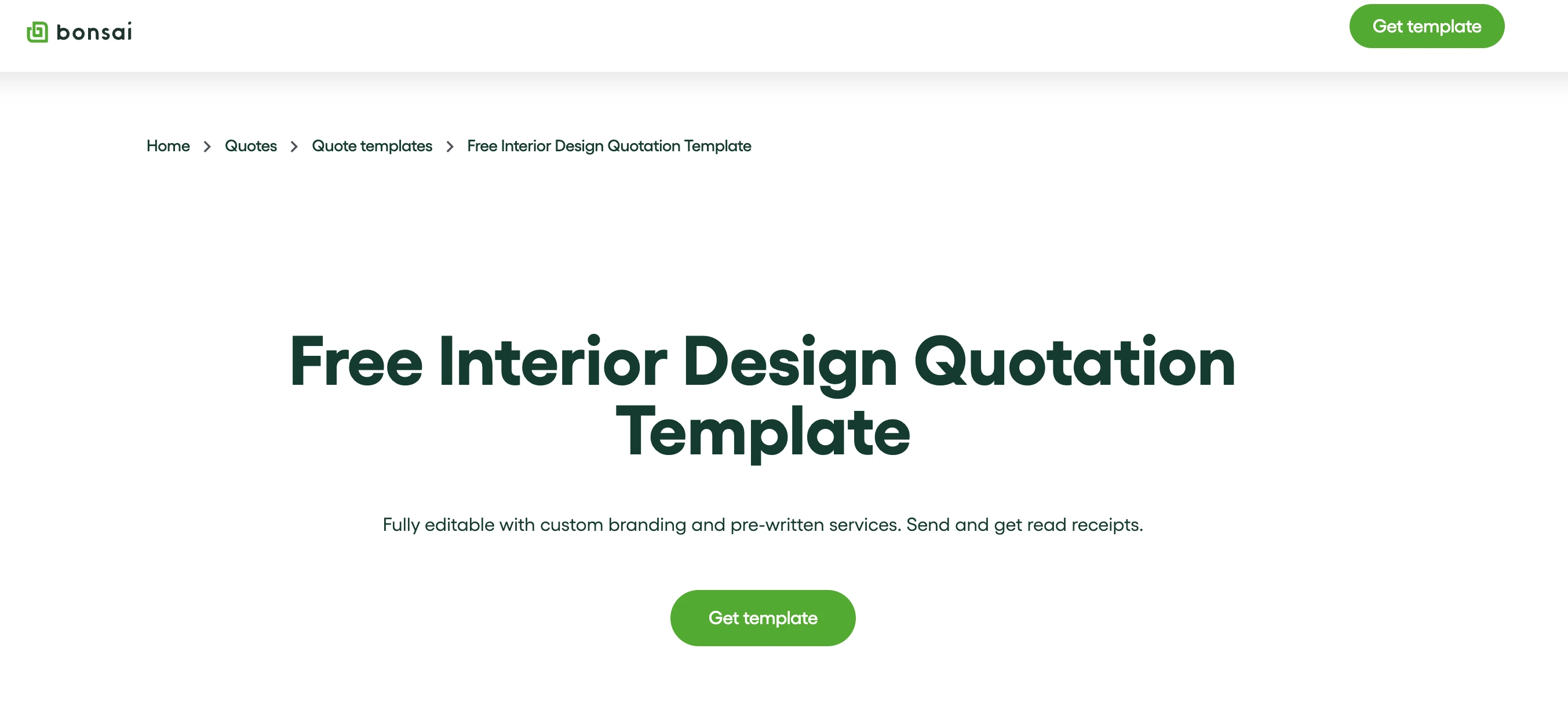Wenn Sie im Bereich Innenarchitektur tätig sind, gibt es eine Sache, die Sie nicht überspringen sollten: den Fragebogen zur Innenarchitektur für Kunden. Es mag wie eine kleine und unwichtige Sache erscheinen, aber es kann entscheidend für eine gut gemachte Arbeit sein.
Das Letzte, was Sie wollen, ist, den gesamten Designprozess zu durchlaufen, nur um dann festzustellen, dass Sie das Ziel völlig verfehlt haben. Die erste Beratung ist sehr wichtig, da sie Ihnen einen guten Eindruck vermittelt, aber Sie müssen auch die richtigen Fragen stellen.
Hinweis: Wenn Sie Zugriff auf alle unsere Innenarchitektur-Tools wünschen, die Ihnen bei der Führung Ihres Freiberufler-Unternehmens helfen (Angebots-, Vertrags- und Rechnungsvorlagen für Innenarchitektur) und Ihr Innenarchitekturunternehmen zu vermarkten, dann probieren Sie Bonsai aus. Verwalten Sie Ihr Freelancer-Geschäft an einem Ort. Probieren Sie Bonsai noch heute für 7 Tage kostenlos.
Warum benötigen Sie einen Kundenfragebogen?
Es gibt verschiedene Gründe, warum Sie einen Fragebogen für Innenarchitektur-Kunden benötigen könnten. Hier erfahren Sie, wie sie Ihnen bei Ihrem ersten Anruf helfen können.
Es setzt klare Erwartungen
Wenn Sie beginnen, Ihre potenziellen Kunden zu befragen, bekommen Sie eine bessere Vorstellung davon, was diese vom Designstil erwarten. Sie erhalten weitere Informationen über ihren Geschmack, ihre Vorlieben, ihr Budget und vieles mehr. Mit Ihrem Kundenfragebogen wissen Sie genau, was Sie erwartet, und werden mit Sicherheit nicht danebenliegen.
Es kann Zeit sparen
Natürlich können Sie Ihren potenziellen Kunden diese Fragen nach und nach stellen, aber das kann wertvolle Zeit kosten. Es ist besser, alle wichtigen Fragen gleich zu Beginn offen anzusprechen. Auf diese Weise wissen Sie nicht nur, in welche Richtung Sie gehen müssen, sondern vermeiden auch Fehler bei der Projektvorlage.
Es füllt fehlende Lücken
Sie und Ihr Kunde müssen sich einig sein. Nehmen wir an, Sie haben Ihre erste Innenarchitekturberatung abgeschlossen und hatten eine gute Vorstellung davon, was Sie tun wollten – aber später hatten Sie neue Fragen. Ein Fragebogen zur Innenarchitektur kann dabei helfen, diese Lücken zu füllen.
Es sorgt für einen guten Eindruck.
Sie mögen vielleicht denken, dass Fragebögen Ihre Kunden langweilen könnten, aber in Wahrheit zeigen sie, wie engagiert Sie sich für Ihr Innenarchitekturbüro einsetzen. Das erste Beratungsgespräch wird ihnen zeigen, dass sie mit Ihrer Dienstleistung eine gute Wahl getroffen haben.
Aspekte eines Fragebogens für Innenarchitektur-Kunden
Jeder Fragebogen für Innenarchitekturkunden sollte bestimmte Punkte erfüllen. Hier ist, was Sie mit Ihren potenziellen Kunden besprechen sollten.
Einführungen
Während des Erstgesprächs sollten Sie allgemeine Höflichkeitsfloskeln ansprechen. Lernen Sie den Kunden besser kennen und geben Sie ihm die Möglichkeit, auch Sie besser kennenzulernen. Sie müssen wissen, dass Sie ein erfolgreiches Unternehmen sind, also sollten Sie ihnen alle Ihre Referenzen und Design-Dienstleistungen zeigen.

Projektvorschlag
Erstellen Sie einen Projektvorschlag mit den Ideen, die sie Ihnen vorgeschlagen haben, zusammen mit technischen Informationen. Dazu können Aspekte wie die Anzahl der Zimmer, der Verwendungszweck der Zimmer, der bevorzugte Stil und alle anderen Informationen gehören, die hier von Bedeutung sein könnten. Hier finden Sie unsere kostenlose Vorlage für Innenarchitektenangebote.
Design
Wenn Sie sich zum ersten Mal mit Ihren Kunden treffen, müssen Sie auch über Ihre Vision sprechen. Welchen Stil soll der Raum haben? Gibt es bestimmte Farben oder Möbeltypen, die besonders günstig sind?
Beispielsweise bevorzugen manche ein helles, minimalistisches Design, während andere eher zu einem dunklen viktorianischen Stil mit viel Schwarz und Rot tendieren. Sprechen Sie über die Einzelheiten des Designs, damit Sie einen schönen Raum gestalten können.
Raum
Um die Arbeit richtig zu erledigen, müssen Sie auch den Platz berücksichtigen. Gehen Sie von einem Raum zum anderen und nehmen Sie alles wahr.
Es könnte hilfreich sein, auch ein paar Fotos von dem Ort zu machen. Nehmen Sie einige Maße und überlegen Sie, wo die Gegenstände für ihren Verwendungszweck am besten Platz finden würden. Wenn Sie beispielsweise bestimmte Dekorationsgegenstände verwenden möchten, sollten Sie sicherstellen, dass diese perfekt in den verfügbaren Raum passen.
Kontakt
Wenn Sie mit neuen Kunden zu tun haben, muss der Fragebogen allgemeine Informationen wie deren Adresse, Telefonnummer und andere nützliche Angaben zum Kunden enthalten.
Während Sie sich in dieser Phase befinden, können Sie sich auch die Nachbarschaft ansehen. Wenn beispielsweise die Nachbarschaft einen bestimmten Stil hat, den der Kunde respektieren möchte, können Sie dies in Ihren Entwurfsprozess einbeziehen.
Hinweis: Bevor Sie einen Fragebogen versenden, sollten Sie sicherstellen, dass Sie durch eine ordnungsgemäße rechtliche Vereinbarung geschützt sind, um spätere Probleme zu vermeiden. Bonsai hat eine kostenlose Vorlage für Innenarchitekturverträge, mit der Sie eine Geschäftsbeziehung mit einem neuen Kunden aufbauen können. Probieren Sie unsere Software noch heute aus.
Fragen für einen Fragebogen zur Innenarchitektur
Es gibt mehrere Fragen, die Sie beim ersten Anruf stellen sollten. Zu diesen Fragen gehören:
Was ist Ihr Projekt?
Das sollte Ihr Gesprächseinstieg sein. Ihr Kunde muss sehen, dass Sie bereit sind, eng mit ihm zusammenzuarbeiten – und das erreichen Sie am besten, indem Sie sich nach seinen Bedürfnissen und Erwartungen erkundigen. Besprechen Sie während der ersten Beratung das Feedback und sprechen Sie über mögliche Lösungen für ihre Probleme.
Wie hoch ist Ihr Budget?
Bei der Erstellung des Kundenfragebogens müssen Innenarchitekten auch nach dem Budget fragen. Manche Menschen werden diese Frage sofort beantworten, während andere sich hinsichtlich ihres Budgets unsicher und unbehaglich fühlen könnten.
Ein neuer Kunde ist möglicherweise unsicher, daher sollten sowohl Sie als auch die Person, die Sie interviewen, ein offenes Gespräch darüber führen. Andernfalls können Sie möglicherweise die Vorstellungen des Kunden nicht erfüllen und gleichzeitig realistische Standards einhalten. Probieren Sie die kostenlose Angebotsvorlage von Bonsai für Innenarchitekten aus.

Wo haben Sie von meinen Dienstleistungen im Bereich Innenausstattung erfahren?
Jedes Detail ist wichtig, daher sollte ein Fragebogen für Neukunden auch die Frage enthalten, wie sie von dem Projekt erfahren haben. Haben sie Sie über das Internet gefunden oder wurden sie von jemand anderem an Sie verwiesen? Notieren Sie sich, Ihren früheren Innenarchitekturkunden für die Weiterempfehlung zu danken.
Wie lauten Ihre Kontaktdaten?
Möglicherweise müssen Sie Ihre potenziellen Kunden für andere Projekte kontaktieren. Deshalb sollte Ihr Fragebogen für Innenarchitekturkunden auch deren Privatadresse, E-Mail-Adresse und Telefonnummer enthalten. Sie können auch gleich nach den Zahlungsdetails fragen. Wenn sie beispielsweise lieber mit dem Geschäftskonto von Bonsai bezahlen möchten, sollten Sie darüber informiert sein.
Abgesehen von der Möglichkeit, mit ihnen in Kontakt zu treten, kann dies auch in anderen Situationen hilfreich sein. Wenn sie beispielsweise nicht in der Nähe Ihres Einzugsgebiets wohnen, können Sie sie an andere Innenarchitekten in ihrer Nähe verweisen.
Haben Sie inspirierende Bilder, die Ihre Ideen repräsentieren können?
Worte sind ein gutes Mittel, um Informationen zu sammeln, aber um die Vision des Kunden wirklich zu verstehen, sollten Sie ihn auch bitten, Ihnen einige Bilder von dem zu zeigen, was er sich vorstellt. Wenn sie Google-Formulare verwenden, um den Online-Fragebogen auszufüllen, können Sie sie bitten, ihre Designideen dort einzureichen.
Gibt es potenzielle Herausforderungen bei diesem Innenarchitekturprojekt?
Vielleicht wohnt der Kunde in einer Mietwohnung, was bedeutet, dass der Innenarchitekt möglicherweise nicht viel Freiheit bei den Aspekten hat, die verändert werden könnten. Oder vielleicht muss die Innenausstattung in kurzer Zeit erledigt werden. So oder so müssen diese Dinge im Voraus besprochen werden.
Welche Designstile mögen Sie, welche mögen Sie nicht?
Ihr Fragebogen zur Innenarchitektur sollte auch Stile enthalten, die ihnen gefallen könnten oder auch nicht. Vielleicht haben sie eine potenzielle Farbpalette, die ihnen gefällt oder die sie absolut nicht mögen. Dadurch können Sie sich ein besseres Bild vom gewünschten Einrichtungsstil machen.
Haben Sie schon einmal mit anderen Innenarchitekten zusammengearbeitet?
Diese Frage kann Ihnen viele relevante Rückmeldungen zu Ihrem potenziellen Kunden liefern. Nehmen wir zum Beispiel an, dass sie zuvor mit jemandem zusammengearbeitet haben, der ihre Erwartungen nicht erfüllen konnte. Oder vielleicht hat ihnen ihre bisherige Tätigkeit wirklich gefallen und sie suchen nach etwas Ähnlichem.
Sie müssen all dies im Voraus wissen, damit Sie deren Erwartungen angemessen erfüllen können. Das Letzte, was Sie wollen, ist, dieselben potenziellen Fehler zu machen, die andere Innenarchitekten gemacht haben.
Gibt es etwas, das Sie behalten möchten?
Auch dies ist eine sehr wichtige Frage, die Sie nicht überspringen sollten. Nehmen wir zum Beispiel an, Ihr Kunde hat einen Teppich mit Tigerprint, den er unbedingt behalten möchte. In diesem Fall muss die Inneneinrichtung einen ähnlichen Stil haben.
Wenn es jedoch nicht zu dem von ihnen gewünschten Design passt, ist es Ihre Aufgabe als Innenarchitekt, Alternativen zu entwickeln.
Wer wird in dem Haus wohnen?
Je nachdem, wer in dem Haus wohnen wird, möchten Sie vielleicht Ihr Projekt darauf abstimmen. Beispielsweise müssen Sie möglicherweise ein Zimmer für einen 30-jährigen Erwachsenen und eines für ein 6-jähriges Mädchen gestalten. Es versteht sich von selbst, dass sie unterschiedliche Wünsche haben werden, daher müssen Sie Ihr Design an ihre Vorlieben anpassen.
Wann soll dieses Projekt abgeschlossen sein?
Je nach dem aktuellen Design Ihres Kunden benötigen Sie möglicherweise etwas mehr Zeit, um Ihr eigenes Modell zu erstellen. Wenn ihre Zeit begrenzt ist, müssen Sie außerdem den Rahmen kennen, damit Sie ein realisierbares Projekt erstellen können.
Berücksichtigen Sie auch die Zeit des Kunden. Wenn sie beispielsweise während dieser Zeit zu Hause oder zumindest in der Nähe sein müssen, kann dies Ihren Prozess erheblich beeinträchtigen. Wenn sie in der Nähe sind, können Sie möglicherweise nicht viel arbeiten. Wenn die Aufgabe schneller erledigt werden muss, können Sie Ihre Zeit optimal nutzen, indem Sie Programme wie Bonsai verwenden.
Das Fazit
Die richtigen Fragen zur richtigen Zeit zu stellen, kann dafür sorgen, dass jedes Ihrer Projekte ein Erfolg wird. Je gründlicher Sie Ihren Fragebogen für Architektenkunden ausfüllen, desto mehr Aufträge werden Sie erhalten.







